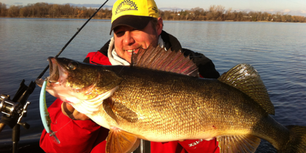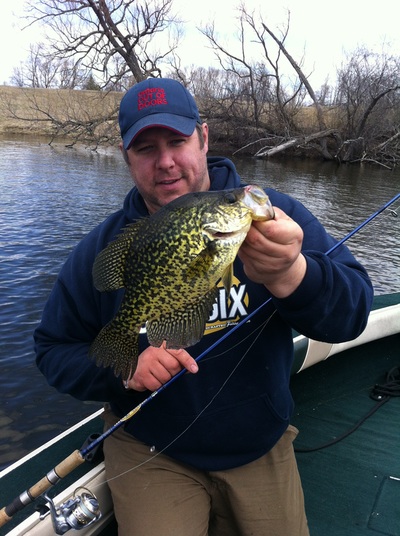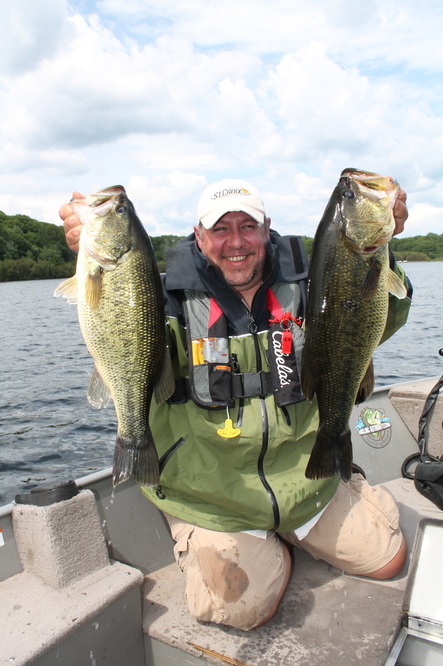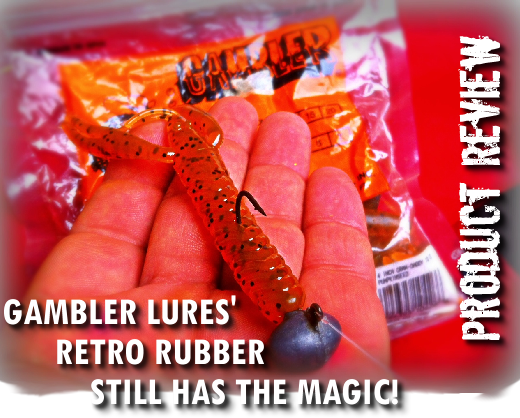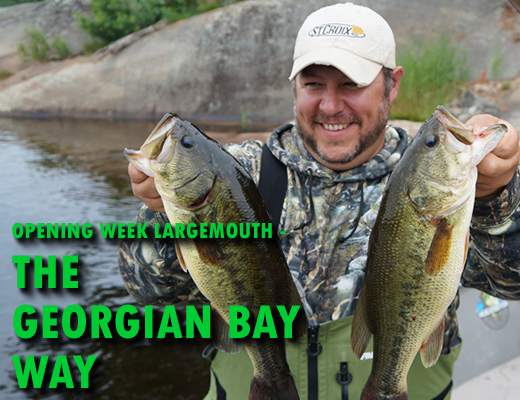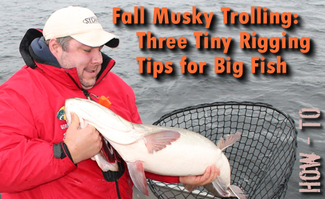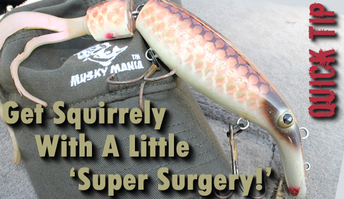School of Fish
Bushey Angle Guided Fishing is the ultimate multi-species, multi-season operation, and this is absolutely one of the biggest advantages I offer my guests. You won't find a more knowledgeable or well-rounded guide anywhere.
This section showcases solid information on the fish species I target, with links to dozens of articles I've had published over the years. Grab a cold drink, get comfy and click on any that interest you. This is the ultimate source for information on fish location, fishing patterns and tackle selection.
This section showcases solid information on the fish species I target, with links to dozens of articles I've had published over the years. Grab a cold drink, get comfy and click on any that interest you. This is the ultimate source for information on fish location, fishing patterns and tackle selection.
How to Catch Walleye
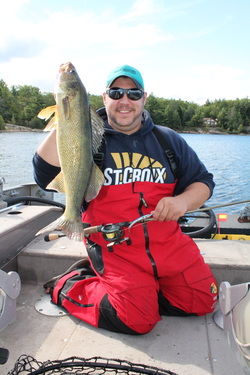
Easily Ontario’s best-loved species, walleye fishing packages with Bushey Angle Guided Fishing truly allow anglers to explore the many faces of the walleye game. Targeting such an adaptable and prolific species, I’ve evolved as a journeyman walleye guy, skilled at rooting these fish out in a variety of lakes and rivers, over all seasons. Be it pitching jigs along a weedline in a shallow, fertile lake along the Trent Severn System or pulling planer boards and crankbaits on The Great Lakes, a big part of my walleye game is versatility.
Consistently locating walleye is the Number 1 key to walleye fishing success. Learning where to look for these fish in different conditions and lake types is one of the most invaluable skills I can teach any angler. Do you consistently catch walleye from shallow weeds early in summer? Would you even believe they’re in there? What about catching eight, ten, even twelve pound walleye on crankbaits under bright sun at midday, in clear water? Do you believe the only way to consistently catch big walleyes is to fish all night and sleep all day? These fish have enough myths surrounding them to fill ten storybooks. I’ll help you discard them once and for all.
Jigging, livebait rigging and a variety of trolling presentations all come into play when you’re walleye fishing. Being well-rounded and willing to switch things up is mandatory. I typically launch my boat with a open mind and an arsenal of tackle to play the game how and where the biting fish want it. I supply my guests with a range of seasonally appropriate artificial and live baits. Some days, there’s just no substitute for fresh, frisky livebait. Nightcrawlers, leeches and a variety of minnow species are always onboard in unlimited supply at no charge. Know what the best bait for summer walleye is? I’ll show you how to rig it for maximum effectiveness. In June, July and August, there’s no substitute.
Be sure to check out my Trophy Hunter Plan for VIP service for gigantic walleye on The Bay Of Quinte and Georgian Bay. Walleye over eight pounds are guaranteed.
Consistently locating walleye is the Number 1 key to walleye fishing success. Learning where to look for these fish in different conditions and lake types is one of the most invaluable skills I can teach any angler. Do you consistently catch walleye from shallow weeds early in summer? Would you even believe they’re in there? What about catching eight, ten, even twelve pound walleye on crankbaits under bright sun at midday, in clear water? Do you believe the only way to consistently catch big walleyes is to fish all night and sleep all day? These fish have enough myths surrounding them to fill ten storybooks. I’ll help you discard them once and for all.
Jigging, livebait rigging and a variety of trolling presentations all come into play when you’re walleye fishing. Being well-rounded and willing to switch things up is mandatory. I typically launch my boat with a open mind and an arsenal of tackle to play the game how and where the biting fish want it. I supply my guests with a range of seasonally appropriate artificial and live baits. Some days, there’s just no substitute for fresh, frisky livebait. Nightcrawlers, leeches and a variety of minnow species are always onboard in unlimited supply at no charge. Know what the best bait for summer walleye is? I’ll show you how to rig it for maximum effectiveness. In June, July and August, there’s no substitute.
Be sure to check out my Trophy Hunter Plan for VIP service for gigantic walleye on The Bay Of Quinte and Georgian Bay. Walleye over eight pounds are guaranteed.
See Some of JP's Walleye Articles & Videos Here:
How to Catch Lake Trout
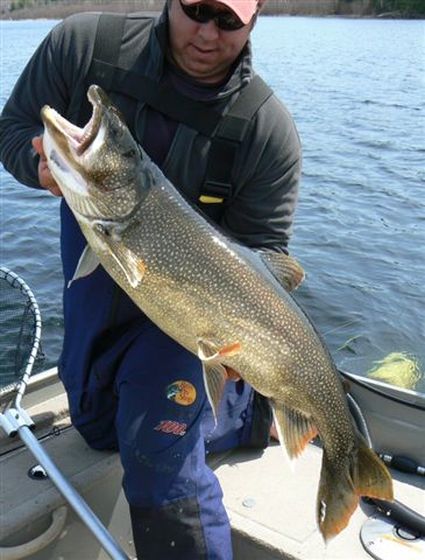
I’ve been a year-round lake trout hound my entire life. These are some of the most brilliantly-coloured, hardest-fighting and impressive fish I target. Lake Simcoe is in my back yard and Georgian Bay is a short distance up the highway. Some of the best lake trout fishing in Ontario is literally at my doorstep. There are also some really good inland lakes I fish. Between open water and icefishing, I typically catch 600 to 800 a season. Lakers are a Bushey Angle specialty.
It’s important to remember that lakers are a cold water fish first and a deep water fish second. Take a second and think about that. For more than half the year, our lakes are cold or completely iced over. What’s my point here? Lake trout are catchable in much shallower water than most realize for a huge part of their lives. They’re really only deep for a few short months, during the heat of summer. Ice-out through early June is a prime window for catching shallow lakers on light tackle. I’ve spent decades honing my methods. Trolling with flatlines, inline planer boards, snap weights, even Dipsey Divers—whatever it takes, I’m set up to do it. Ever caught a big lake trout propwash trolling, like you would for muskie? We catch huge fish every spring like this! Don’t believe it? Come see it!
Downrigging during the summer months is really productive and totally accessible for anyone to enjoy. I’ll teach you more about downrigger fundamentals in one day than you’ll believe. I’ve been downrigging for lake trout for thirty years. Getting your sonar tweaked and dialed in is a must. I’ll show you 3 simple steps for fine-tuning your electronics that will help you become a consistent downrigger angler.
Vertical jigging for lakers is like nothing else and definitely one of my most popular services. There isn’t a fish out there that hammers a well-presented jigging lure the way a lake trout can. No matter where you’re comfortable jigging from aboard my boat, you’ve got a full-colour, sonar/GPS to watch your lure on. Watching big trout streak up to your bait and then feeling them hit it just can’t be beat! Lake trout jigging is a great compliment to a downrigging shift when winds permit and an excellent bonus during a trip for other species. I fish a good mix of hard jigging lures (spoons, blade baits) and soft plastics (tubes, swimbaits).
I specialize in ice fishing for lake trout all winter. The fishing is outstanding and the whole experience revolves around your safety and comfort, with top-of-the-industry heated shelters, ice electronics, and the best ice fishing lures. And of course, brace yourself for shoulder-popping fights from plenty of solid fish. Groups of any size can be accommodated.
Being such a slow-growing, majestic and delicate fish, I preach clean Catch & Release and the ethical harvest of lake trout. I’ll happily clean and package smaller fish for you to enjoy during your trip. They’re excellent eating. But expect to let those larger fish swim away to fight another day. Lake trout are one of Ontario’s crown jewels, and you’ll be in the hands of an expert.
It’s important to remember that lakers are a cold water fish first and a deep water fish second. Take a second and think about that. For more than half the year, our lakes are cold or completely iced over. What’s my point here? Lake trout are catchable in much shallower water than most realize for a huge part of their lives. They’re really only deep for a few short months, during the heat of summer. Ice-out through early June is a prime window for catching shallow lakers on light tackle. I’ve spent decades honing my methods. Trolling with flatlines, inline planer boards, snap weights, even Dipsey Divers—whatever it takes, I’m set up to do it. Ever caught a big lake trout propwash trolling, like you would for muskie? We catch huge fish every spring like this! Don’t believe it? Come see it!
Downrigging during the summer months is really productive and totally accessible for anyone to enjoy. I’ll teach you more about downrigger fundamentals in one day than you’ll believe. I’ve been downrigging for lake trout for thirty years. Getting your sonar tweaked and dialed in is a must. I’ll show you 3 simple steps for fine-tuning your electronics that will help you become a consistent downrigger angler.
Vertical jigging for lakers is like nothing else and definitely one of my most popular services. There isn’t a fish out there that hammers a well-presented jigging lure the way a lake trout can. No matter where you’re comfortable jigging from aboard my boat, you’ve got a full-colour, sonar/GPS to watch your lure on. Watching big trout streak up to your bait and then feeling them hit it just can’t be beat! Lake trout jigging is a great compliment to a downrigging shift when winds permit and an excellent bonus during a trip for other species. I fish a good mix of hard jigging lures (spoons, blade baits) and soft plastics (tubes, swimbaits).
I specialize in ice fishing for lake trout all winter. The fishing is outstanding and the whole experience revolves around your safety and comfort, with top-of-the-industry heated shelters, ice electronics, and the best ice fishing lures. And of course, brace yourself for shoulder-popping fights from plenty of solid fish. Groups of any size can be accommodated.
Being such a slow-growing, majestic and delicate fish, I preach clean Catch & Release and the ethical harvest of lake trout. I’ll happily clean and package smaller fish for you to enjoy during your trip. They’re excellent eating. But expect to let those larger fish swim away to fight another day. Lake trout are one of Ontario’s crown jewels, and you’ll be in the hands of an expert.
More on Lake Trout? Catch Some of JP's Articles & Videos Here:
How to Catch Pike
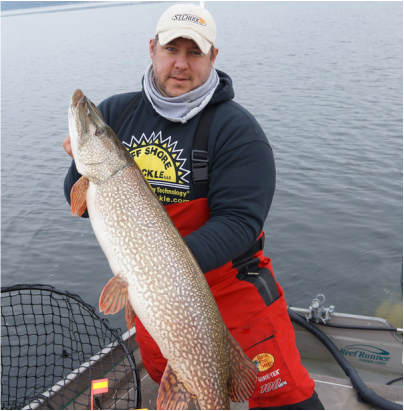
From early May through freeze-up and into the ice fishing season, pike are one of my favorite species to target. I’ve spent my entire life pike fishing in Ontario. Being a cold-water predator, locating big pike takes drastically different mindsets from one calendar period to the next. During winter, spring and fall, some of the biggest fish available are at their most accessible, operating comfortably in relatively shallow water. During mid to late summer, these same fish lead a lifestyle that’s more in line with lake trout. Deeper, colder water and specific, high-quality baitfish are a big part of the puzzle.
Early in the season and into mid-June most years, a range of fairly standard casting presentations work. Depending on fish mood and the types of cover present, I have great success on a family of lures many pike anglers pass over: jigs. These lures hook pike cleanly and solidly, they burrow through all types of cover and structure easily and maybe most importantly of all, they can be used over a phenomenally broad spectrum of depths and retrieve speeds. This is a fantastic time of the year (and pattern) for catching a ton of fish. Casting for pike is about as fun as it gets. Catching 40” pike in spring is a regular occurrence. Plenty surpass that mark every year, too.
In late summer and well into fall, trolling for suspended pike is one of my specialties. Some freakishly big fish spend the majority of their time nowhere near weed beds, shoals or any other kind of structure. Intelligent use of my sonar/GPS and the application of a small handful of battle-proven trolling baits is what makes this system hum. I’ve dedicated years to patterning the running depths and optimal trolling speeds for my lures. Some of the most effective are custom airbrushed baits I’ve painted, myself.
I specialize in ice fishing for big pike. These trips are the ultimate in comfort, safety and convenience for any angler. Applying both tip-up and jigging methods, this is bar-none the most prime window for the biggest pike of your life. Top-of-the industry heated ice shelters, underwater colour cameras and sonars all make my big pike ice trips a ‘can’t miss.’ They’re ideal for families or large groups of anglers. Check out my Trophy Hunter Plan for icefishing trips on some of Ontario’s best pike lakes.
Early in the season and into mid-June most years, a range of fairly standard casting presentations work. Depending on fish mood and the types of cover present, I have great success on a family of lures many pike anglers pass over: jigs. These lures hook pike cleanly and solidly, they burrow through all types of cover and structure easily and maybe most importantly of all, they can be used over a phenomenally broad spectrum of depths and retrieve speeds. This is a fantastic time of the year (and pattern) for catching a ton of fish. Casting for pike is about as fun as it gets. Catching 40” pike in spring is a regular occurrence. Plenty surpass that mark every year, too.
In late summer and well into fall, trolling for suspended pike is one of my specialties. Some freakishly big fish spend the majority of their time nowhere near weed beds, shoals or any other kind of structure. Intelligent use of my sonar/GPS and the application of a small handful of battle-proven trolling baits is what makes this system hum. I’ve dedicated years to patterning the running depths and optimal trolling speeds for my lures. Some of the most effective are custom airbrushed baits I’ve painted, myself.
I specialize in ice fishing for big pike. These trips are the ultimate in comfort, safety and convenience for any angler. Applying both tip-up and jigging methods, this is bar-none the most prime window for the biggest pike of your life. Top-of-the industry heated ice shelters, underwater colour cameras and sonars all make my big pike ice trips a ‘can’t miss.’ They’re ideal for families or large groups of anglers. Check out my Trophy Hunter Plan for icefishing trips on some of Ontario’s best pike lakes.
Catch some of JP's Pike Videos & Articles Here:
How to Catch Panfish: Perch + Crappie
The area I guide in really is home to some of the finest year-round fishing for perch and crappie anywhere in the world. Consistent panfishing is all about location. These little fish move very predictably based on seasonal trends. Not only that, they also constantly move from one day to the next, chasing their preferred foods and seeking security from predators like bass, pike and muskie. Perch fishing on Lake Simcoe is some of the best on earth. Her clear, diverse waters not only produce some of the biggest perch you’ll catch anywhere, but some of the prettiest, too. There’s a range of outstanding lakes I fish for crappie and like perch, the fish grow big and are available all year round.
Catching spring perch and crappie isn’t complicated. Shallower, fast-warming coves and bays typically draw them in the days and weeks following ice-out. These fish are both spring spawners, and also feed heavily on small shiner and dace minnows, as well as all kinds of insect life. Wood cover of any kind holds food and warm water. Docks, fallen trees, beaver piles or bridge posts are all top crappie spots. So are standing bulrushes, wild cane and old, decayed weed clumps. Crappie love solid, vertical cover that they can butt up against. On Lake Simcoe, sand/weed combos are the draw for perch, along with smaller, scattered rock rubble. Rigging slip bobbers with a variety of small tubes, grubs or feather/hair jigs is as complicated as it needs to be, most days. These fish nearly always prefer lures suspended over top of them, so adjusting the depth of your jig becomes really key.
In summer and fall, we fish deeper water and also target a lot of suspended perch and crappie. Dragging rockpiles, sandy flats and shoals for perch with downsized dropshot rigs in 20-30 feet of water is a mainstay. Have you ever trolled for big crappie using small crankbaits? This is a tremendous method, and one not many people capitalize on. For every technique, expect to fully enjoy these little scrappers on lightweight, high-quality rods and reels. Feel that crisp little tap? Sweep the hook in and enjoy the fight!
Winter ice fishing for perch and crappie is fantastic fun. And Bushey Angle Guided Fishing is set up to handle groups of any size. Some of the best action takes place in shallow water, as soon as we’ve got safe ice in early January. For fishing with kids, this is as good as it gets! Click on my Underwater Icefishing Films to see some of the best underwater panfish videos you’ll ever find.
Catching spring perch and crappie isn’t complicated. Shallower, fast-warming coves and bays typically draw them in the days and weeks following ice-out. These fish are both spring spawners, and also feed heavily on small shiner and dace minnows, as well as all kinds of insect life. Wood cover of any kind holds food and warm water. Docks, fallen trees, beaver piles or bridge posts are all top crappie spots. So are standing bulrushes, wild cane and old, decayed weed clumps. Crappie love solid, vertical cover that they can butt up against. On Lake Simcoe, sand/weed combos are the draw for perch, along with smaller, scattered rock rubble. Rigging slip bobbers with a variety of small tubes, grubs or feather/hair jigs is as complicated as it needs to be, most days. These fish nearly always prefer lures suspended over top of them, so adjusting the depth of your jig becomes really key.
In summer and fall, we fish deeper water and also target a lot of suspended perch and crappie. Dragging rockpiles, sandy flats and shoals for perch with downsized dropshot rigs in 20-30 feet of water is a mainstay. Have you ever trolled for big crappie using small crankbaits? This is a tremendous method, and one not many people capitalize on. For every technique, expect to fully enjoy these little scrappers on lightweight, high-quality rods and reels. Feel that crisp little tap? Sweep the hook in and enjoy the fight!
Winter ice fishing for perch and crappie is fantastic fun. And Bushey Angle Guided Fishing is set up to handle groups of any size. Some of the best action takes place in shallow water, as soon as we’ve got safe ice in early January. For fishing with kids, this is as good as it gets! Click on my Underwater Icefishing Films to see some of the best underwater panfish videos you’ll ever find.
Catch one of JP's Panfish Articles Here: |
How to Catch Whitefish
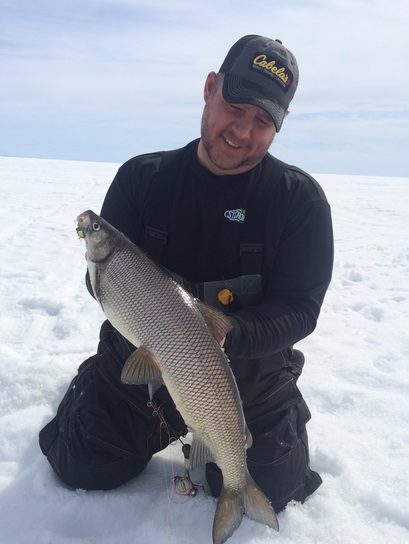
Alongside lake trout, whitefish are an exciting and dynamic species lots of anglers overlook and misunderstand. On Lake Simcoe, whitefish feeding patterns have undergone a huge shift in the past decade. Native smelt and herring populations now play second fiddle to an unlikely and unusual member of the foodchain: gobies. Whitefish gorge on these critters and as a result, they forage in interesting ways. Working the lake’s floor with both downrigging and vertical jigging methods keeps guests busy with these broad, chrome-coloured brawlers all season. The open water season begins May 15 and some fantastic fishing occurs on shoals and rocky transitions where lots of gobies are found in 30 to 50 feet of water.
Calm weather is ideal for summer jigging. Do you know how to do The Whitefish Wiggle? What about jigging in the “dustbowl?” What are the best icefishing lures for whitefish? I use some of the most productive jigging lures and techniques you’ll find anywhere. The whitefish strike takes lots of practice to convert. No other type of fish hits that lightly but that quickly. It’s all about touch and feel. Rigging up for success is critical! I’ll show you 2 tackle tips that will up your success immediately.
My downrigging game is highly specialized and designed for guests of any skill level to enjoy. Fishing the bottom requires real attention to detail, in terms of how much line is let out behind the cannonball and lure type. The best trolling speed for whitefish is also a major factor and varies from day to day. Does downrigging automatically make you think of winching in fish using heavy rods and reels without enjoying the fight? You’re in for a real treat with Bushey Angle Guided Fishing. We fish long, soft rods, small reels and light, 8 to 10 pound test monofilament line. The average whitefish we catch are five pounds and up, with fish from eight to almost ten pounds available. It’s incredibly fun.
Lake Simcoe is without question the best whitefish lake in the world and the icefishing for them is tremendous. I specialize in winter packages that are safe, comfortable and unbeatable for providing guests with hands-on instruction. It’s convenient, fun and ideal for groups of any size. In the winter of 2016, I landed a real monster measuring almost 34 inches long! That one’s still swimming after a quick measurement and gentle release. The only question now? How big will she be when YOU catch her?
On the table, whitefish are excellent. I’ll professionally clean and package any fish you’d like to take home.
Calm weather is ideal for summer jigging. Do you know how to do The Whitefish Wiggle? What about jigging in the “dustbowl?” What are the best icefishing lures for whitefish? I use some of the most productive jigging lures and techniques you’ll find anywhere. The whitefish strike takes lots of practice to convert. No other type of fish hits that lightly but that quickly. It’s all about touch and feel. Rigging up for success is critical! I’ll show you 2 tackle tips that will up your success immediately.
My downrigging game is highly specialized and designed for guests of any skill level to enjoy. Fishing the bottom requires real attention to detail, in terms of how much line is let out behind the cannonball and lure type. The best trolling speed for whitefish is also a major factor and varies from day to day. Does downrigging automatically make you think of winching in fish using heavy rods and reels without enjoying the fight? You’re in for a real treat with Bushey Angle Guided Fishing. We fish long, soft rods, small reels and light, 8 to 10 pound test monofilament line. The average whitefish we catch are five pounds and up, with fish from eight to almost ten pounds available. It’s incredibly fun.
Lake Simcoe is without question the best whitefish lake in the world and the icefishing for them is tremendous. I specialize in winter packages that are safe, comfortable and unbeatable for providing guests with hands-on instruction. It’s convenient, fun and ideal for groups of any size. In the winter of 2016, I landed a real monster measuring almost 34 inches long! That one’s still swimming after a quick measurement and gentle release. The only question now? How big will she be when YOU catch her?
On the table, whitefish are excellent. I’ll professionally clean and package any fish you’d like to take home.
See Some of JP's Whitefish Videos Here:
|
|
|
How to Catch Bass:
Smallmouth |
Largemouth |
See some of JP's Bass Videos and Articles Here:
|
A wicked new method I'm using with BaitCloud chips and dust. Walleye, smallmouth, largemouth, lake trout and whitefish love scented plastics.
|
How to Catch Muskie
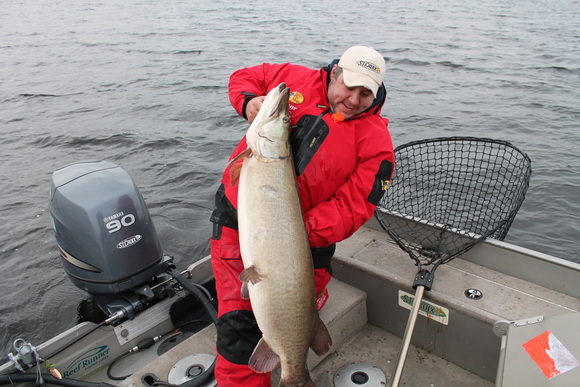
No fish carries more mythical weight than the muskie. People hear about these magical fish that eat once a month, take 10,000 casts to connect with and bring anglers to their knees. I fish some of the finest muskie water on earth and have for my entire life. The Canadian Record Muskie was caught off a shoal that has also smiled on me as well, with a handful of truly huge fish. Are you ready to toss the fables and challenges out the window and get down to work with me? Want to gain rock-solid mastery over the essential fundamentals of muskie fishing?
I spend the bulk of my season on Ontario’s Georgian Bay, The Lower French River and the West Arm of Lake Nipissing. More scenic and unspoiled than anywhere on the planet, these fisheries don’t give up their giants easily. But make no mistake, I’ll put you in the best possible position for the strike that changes your life.
I split time between casting and trolling techniques for muskie. Like pike and walleye, muskie seasons open in Ontario a few weeks apart, depending on location. Inland fishing opens in early June, while Georgian Bay isn’t until the third Saturday. This can be a prime window for those superfish that spend very little time around inshore habitat. The character of a spot (size, density of cover, sharp twists, pockets, points or turns) is how I determine how I’ll best set up and work it. Tight, ‘spot-on-the-spot’ stuff can be raked using a few precise casts. On the flipside, deeper or more expansive spots get worked using accurate trolling passes. When that drag starts to scream and the rod bucks over in the rod holder, it’s all yours. Some of the best spots for muskie produce fish year after year. It really is amazing.
Much of the water I fish is ‘blade country.’ Inline spinners and spinnerbaits are the multi-tools in my arsenal. Do you run these baits trolling? Not enough muskie fishermen do. They’re just as deadly trolled as casted. More traditional crankbaits are equally good. In fall, I work world-class structures loaded with prime forage. Big things happen. Topwaters, rubber baits and jerkbaits are also all valuable lure styles you’ll learn. Rods, reels, hooks, leaders and release tools are critical to my muskie game. I’ll teach you the details.
Muskie fishing with Bushey Angle Guided Fishing is 100% Catch and Release. I’ll make sure to get magazine-quality muskie pics, along with 1080dp video of your big moment. These will come in handy, should you desire a replica mount, preserving your trophy. Big fish are measured accurately and girthed in-water, using a soft tape and bump board.
Make sure to check out my Trophy Hunter Plan for VIP service on Georgian Bay, The Lower French River and The West Arm of Lake Nipissing.
I spend the bulk of my season on Ontario’s Georgian Bay, The Lower French River and the West Arm of Lake Nipissing. More scenic and unspoiled than anywhere on the planet, these fisheries don’t give up their giants easily. But make no mistake, I’ll put you in the best possible position for the strike that changes your life.
I split time between casting and trolling techniques for muskie. Like pike and walleye, muskie seasons open in Ontario a few weeks apart, depending on location. Inland fishing opens in early June, while Georgian Bay isn’t until the third Saturday. This can be a prime window for those superfish that spend very little time around inshore habitat. The character of a spot (size, density of cover, sharp twists, pockets, points or turns) is how I determine how I’ll best set up and work it. Tight, ‘spot-on-the-spot’ stuff can be raked using a few precise casts. On the flipside, deeper or more expansive spots get worked using accurate trolling passes. When that drag starts to scream and the rod bucks over in the rod holder, it’s all yours. Some of the best spots for muskie produce fish year after year. It really is amazing.
Much of the water I fish is ‘blade country.’ Inline spinners and spinnerbaits are the multi-tools in my arsenal. Do you run these baits trolling? Not enough muskie fishermen do. They’re just as deadly trolled as casted. More traditional crankbaits are equally good. In fall, I work world-class structures loaded with prime forage. Big things happen. Topwaters, rubber baits and jerkbaits are also all valuable lure styles you’ll learn. Rods, reels, hooks, leaders and release tools are critical to my muskie game. I’ll teach you the details.
Muskie fishing with Bushey Angle Guided Fishing is 100% Catch and Release. I’ll make sure to get magazine-quality muskie pics, along with 1080dp video of your big moment. These will come in handy, should you desire a replica mount, preserving your trophy. Big fish are measured accurately and girthed in-water, using a soft tape and bump board.
Make sure to check out my Trophy Hunter Plan for VIP service on Georgian Bay, The Lower French River and The West Arm of Lake Nipissing.

